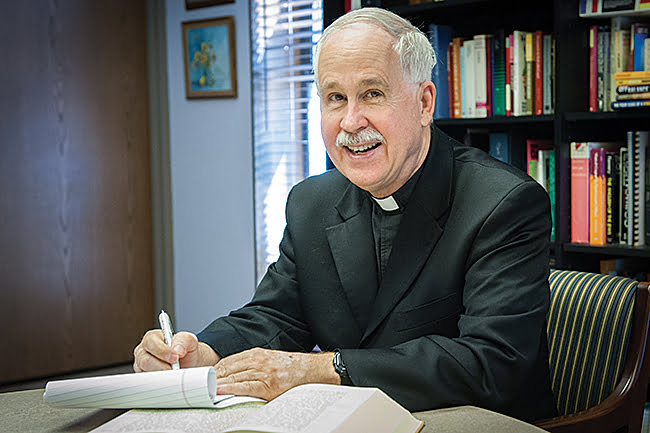
Father Mike Stubbs is the pastor of Holy Cross Parish in Overland Park and has a degree in Scripture from Harvard University.
by Father Mike Stubbs
The essentials of every baptism remain the same, no matter what person is being baptized. The details may differ.
Compare a screaming infant to an adult catechumen at the Easter Vigil. It may look and sound very different, even though it is the same sacrament.
But why should Jesus have been baptized? He had no sins to be forgiven, no original sin to wash away.
The answer comes that Jesus consented to be baptized in order to set an example for us and to express solidarity with the crowds who had come to John the Baptist to be baptized.
This Sunday we celebrate the feast of the Baptism of the Lord. It gives us the opportunity to reflect more deeply on Jesus’ baptism. We will hear the account provided in Lk 3:15-16, 21-22.
Luke’s account of Jesus’ baptism closely parallels the accounts in the Gospels of Matthew and Mark. Only a couple of differences stand out. Both of those differences represent characteristics typical of Luke’s Gospel.
Compared to Mark and Matthew, Luke likes to emphasize the prayer in Jesus’ life. For example, Luke provides prayer as the motivation for Jesus climbing the mountain where the Transfiguration takes place and describes Jesus praying (Lk 9:28).
Accordingly, Luke brings in the element of prayer at the moment of Jesus’ baptism: “Jesus also had been baptized and was praying.” This is something that Mark and Matthew do not touch upon.
By mentioning prayer, Luke frames this event as a moment of private communication between Jesus and God, even though a large crowd is present. Jesus is praying, and God responds to Jesus. Luke describes this response: “And a voice came from heaven, ‘You are my beloved Son; with you I am well pleased.’”
According to Luke, this response is directed to Jesus, and not to the crowd, as in Matthew’s Gospel.
All three Gospels mention the Holy Spirit descending like a dove upon Jesus at the moment of his baptism. But only Luke specifies that the Holy Spirit descends like a dove in bodily form.
This detail makes the descent of the Holy Spirit more concrete. When Mark and Matthew describe the Holy Spirit descending like a dove, they could mean that the Holy Spirit descended as a dove would descend. They could refer more to the manner, rather than the visible appearance of the Holy Spirit.
Luke’s description of the Holy Spirit as appearing in bodily form places greater emphasis on the Holy Spirit. That greater emphasis correlates well to the rest of Luke’s Gospel, as well as the Acts of the Apostles, which Luke also wrote. Luke consistently draws attention to the action of the Holy Spirit in Jesus’ life, as well as in the life of the church.
What can we learn from Luke’s account of Jesus’ baptism? He reinforces our belief that our own baptism calls us to a life of prayer and to a life where the Holy Spirit is at work.

